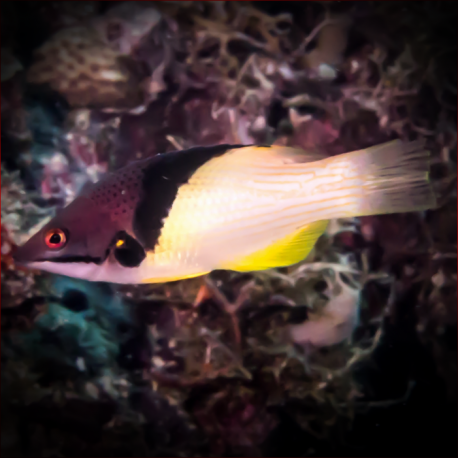More info
Datasheet
| Minimum Tank Size | 800 litres / 211.34 US gallons |
| Maximum Size | 25.0cm / 9.84inches |
| Reef Compatible | Reef safe with caution |
| Temperament | Might be aggressive towards other species |
| Temperature | 22.2°C / 71.96°F - 25.6°C / 78.08°F |
| Specific Gravity | 1.020-1.025 |
| Carbonate Hardness | 8-12 |
| pH | 8.1-8.4 |
General Description
The Coral Hogfish (Bodianus mesothorax) is a member of the Labridae family, known for their distinctive manner of foraging food by sifting through the substrate with their elongated snouts. These fish are native to regions such as Australia, Indonesia, the East Pacific, and Central/West Pacific, where they can be observed trailing fish that disturb the sand. Fully grown, they can reach sizes of up to 25.0cm and are recognized for their vibrant coloring and unique hunting behavior.
Aquarium Suitability
Considered suitable for aquariums with caution, Coral Hogfish are known to exhibit aggressive behavior, particularly towards peaceful or docile species. In an aquarium setting, they are effective hunters of invertebrates, preying on crustaceans, sea urchins, and worms. Due to their territorial nature and potential for aggression, they are best kept with species that can withstand their behavior. Additionally, they require a significant amount of space to move and hide, making them challenging to accommodate in smaller tanks.
Care and Hardiness
Coral Hogfish are classified as hardy fish, adapting well to various water conditions within the recommended parameters of pH (8.1-8.4), temperature (22.2-25.6°C), and salinity (1.020-1.025). To mitigate their aggressive tendencies, regular feeding, ample hiding spots, and a spacious environment are essential. These fish have the ability to change gender from female to male, a process that occurs when a male presence is required in the group.
Reef Suitability
While Coral Hogfish are labeled as reef safe with caution, their propensity for hunting invertebrates can pose a threat to certain reef inhabitants such as worms, snails, and small crustaceans. Careful consideration is advised when incorporating them into a reef tank to prevent harm to other organisms in the ecosystem.
Aquarium Setup
Creating an ideal habitat for Coral Hogfish involves providing plenty of hiding spots, such as spaces between live rocks, to accommodate their need for concealment. Additionally, securing rocks and substrate to prevent toppling is recommended, as these fish have a habit of rearranging their surroundings. A tank size of at least 800 liters is suggested to allow for ample swimming space and to reduce territorial disputes.
Behaviour
Coral Hogfish are known for their active swimming behavior and territorial instincts. They are likely to exhibit aggression towards other fish species, particularly those perceived as threats or competitors. Understanding their behavior patterns and providing an environment that caters to their need for space and security can help manage their temperament in a home aquarium.
Feeding and Diet
In captivity, Coral Hogfish thrive on a diet consisting of larger crustaceans like shrimp and crabs, as well as other invertebrates such as krill, mysis, and artemia. Their efficient hunting skills make them adept at capturing live prey within the aquarium, making it essential to offer a varied and nutritious diet to meet their dietary requirements.
Dimorphism and Captive Reproduction
Coral Hogfish possess the unique ability to change gender, transitioning from female to male as needed within their social structure. This adaptation allows them to maintain a balance in the population dynamics of their group. While their reproductive behavior in captivity is not extensively documented, the species' hermaphroditic traits contribute to their fascinating biology.
Habitat and Distribution
In their natural habitat, Coral Hogfish are commonly found in regions across Australia, Indonesia, and the Pacific Ocean. They inhabit rocky reefs and coral formations, utilizing their foraging skills to obtain food hidden within the substrate. Their distribution in these areas highlights their preference for tropical marine environments with ample opportunities for hunting and shelter.

